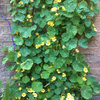Anomalous Zinnia
oxmyx
16 years ago
True it is to some no-beievers ~~> this is an image from one zinnia plant. I double checked it comes from the same mail stem.
Pinstriped Zinnias can have varying degrees of color, and an overabundance of one, but I have never seen a single colored one.
{{gwi:23018}}


sarahbarah27
oxmyxOriginal Author
Related Professionals
Parole Landscape Architects & Landscape Designers · Berkley Landscape Contractors · Forest Hills Landscape Contractors · Huntington Landscape Contractors · Merced Landscape Contractors · Pleasant Grove Landscape Contractors · Ridgewood Landscape Contractors · Roswell Landscape Contractors · St. Louis Landscape Contractors · Vineyard Landscape Contractors · West Orange Landscape Contractors · Bowie Decks, Patios & Outdoor Enclosures · Hendersonville Decks, Patios & Outdoor Enclosures · Pittsburgh Decks, Patios & Outdoor Enclosures · Puyallup Decks, Patios & Outdoor Enclosuresmaineman
oxmyxOriginal Author
maineman
oxmyxOriginal Author
maineman
oxmyxOriginal Author
shapiro
oxmyxOriginal Author
maineman
shapiro
maineman
jackier_gardener
oxmyxOriginal Author
maineman
jackier_gardener
maineman
jackier_gardener
maineman
mauch1